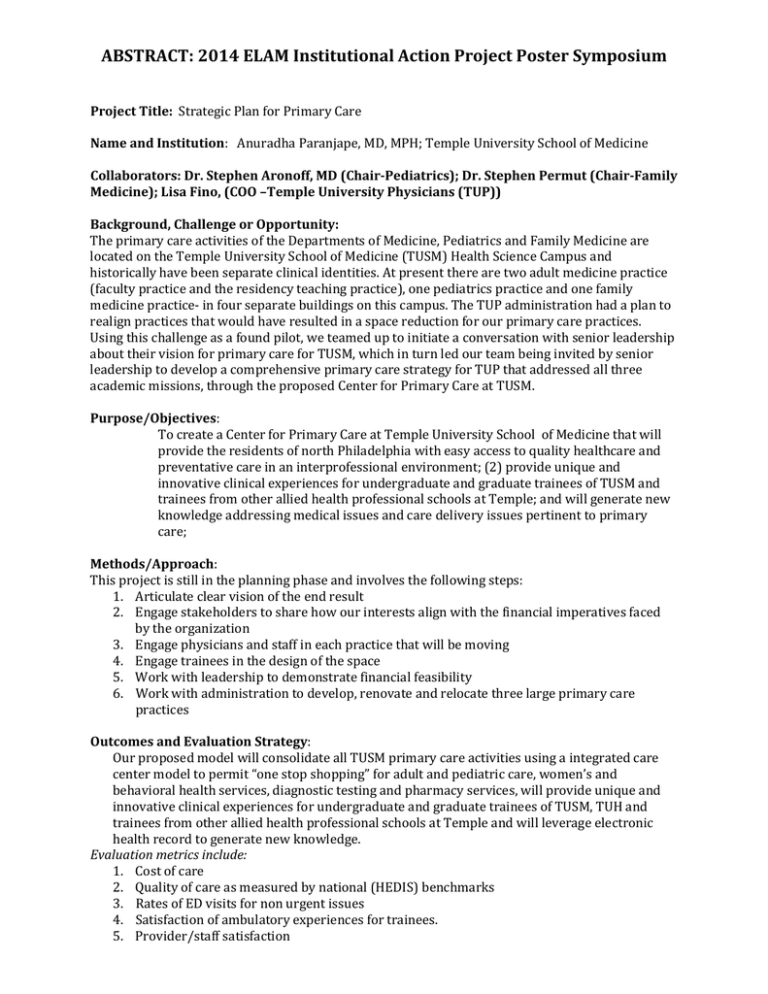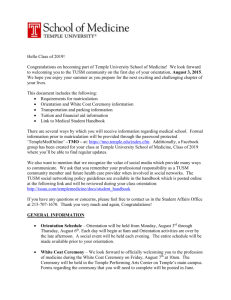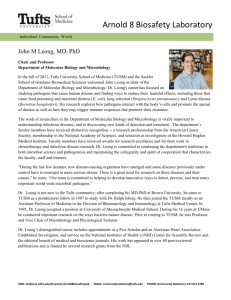ABSTRACT: 2014 ELAM Institutional Action Project Poster Symposium
advertisement

ABSTRACT: 2014 ELAM Institutional Action Project Poster Symposium Project Title: Strategic Plan for Primary Care Name and Institution: Anuradha Paranjape, MD, MPH; Temple University School of Medicine Collaborators: Dr. Stephen Aronoff, MD (Chair-Pediatrics); Dr. Stephen Permut (Chair-Family Medicine); Lisa Fino, (COO –Temple University Physicians (TUP)) Background, Challenge or Opportunity: The primary care activities of the Departments of Medicine, Pediatrics and Family Medicine are located on the Temple University School of Medicine (TUSM) Health Science Campus and historically have been separate clinical identities. At present there are two adult medicine practice (faculty practice and the residency teaching practice), one pediatrics practice and one family medicine practice- in four separate buildings on this campus. The TUP administration had a plan to realign practices that would have resulted in a space reduction for our primary care practices. Using this challenge as a found pilot, we teamed up to initiate a conversation with senior leadership about their vision for primary care for TUSM, which in turn led our team being invited by senior leadership to develop a comprehensive primary care strategy for TUP that addressed all three academic missions, through the proposed Center for Primary Care at TUSM. Purpose/Objectives: To create a Center for Primary Care at Temple University School of Medicine that will provide the residents of north Philadelphia with easy access to quality healthcare and preventative care in an interprofessional environment; (2) provide unique and innovative clinical experiences for undergraduate and graduate trainees of TUSM and trainees from other allied health professional schools at Temple; and will generate new knowledge addressing medical issues and care delivery issues pertinent to primary care; Methods/Approach: This project is still in the planning phase and involves the following steps: 1. Articulate clear vision of the end result 2. Engage stakeholders to share how our interests align with the financial imperatives faced by the organization 3. Engage physicians and staff in each practice that will be moving 4. Engage trainees in the design of the space 5. Work with leadership to demonstrate financial feasibility 6. Work with administration to develop, renovate and relocate three large primary care practices Outcomes and Evaluation Strategy: Our proposed model will consolidate all TUSM primary care activities using a integrated care center model to permit “one stop shopping” for adult and pediatric care, women’s and behavioral health services, diagnostic testing and pharmacy services, will provide unique and innovative clinical experiences for undergraduate and graduate trainees of TUSM, TUH and trainees from other allied health professional schools at Temple and will leverage electronic health record to generate new knowledge. Evaluation metrics include: 1. Cost of care 2. Quality of care as measured by national (HEDIS) benchmarks 3. Rates of ED visits for non urgent issues 4. Satisfaction of ambulatory experiences for trainees. 5. Provider/staff satisfaction The Center for Primary Care: Temple University School of Medicine Anuradha Paranjape, MD, MPH Collaborators: Stephen Aronoff, MD, MBA; Stephen Permut, MD, JD; Lisa Fino, BS. Approach Background Primary care activities for TUSM faculty practice plan historically divided into 4 distinct clinical units: 1. Pediatrics 2. Family Medicine 3. Internal Medicine-Faculty Practice 4. Internal Medicine-Residency Teaching Practice An integrated primary care center offers economies of scale and has been shown to be an effective care delivery model in underserved neighborhoods Restructured reimbursement models that focus on quality over volume have been formulated Practice relocations planned for FY14 would have resulted in reductions in space for all practices The physical space inspired the development of a strategic plan for primary care at TUSM Objectives To create a Center for Primary Care at Temple University School of Medicine that will : Provide the residents of North Philadelphia with easy access to quality healthcare and preventative care Provide unique and innovative clinical experiences for undergraduate and graduate trainees both from TUSM and trainees other allied health professional schools at TUSM Generate new knowledge addressing medical issues and care delivery issues pertinent to primary care Planned structure Articulate vision Engage Assess outcomes leadership Operationalize practice integration plans Engage Center for Primary Care stakeholders Identify The Center for Primary Care will: provide ‘one stop shopping’ for adult and pediatric care, women’s and behavioral health services, diagnostic testing, phlebotomy and pharmacy services Single registration Point of care testing include xrays Ability to hold patients for observation (e.g Rx of asthma, DM exacerbations, dehydration) Offer same day appointments with extended hours Be certified as a Patient Centered Medical Home Provide a venue for an longitudinal integrated 3rd year clerkship Use the Electronic Health Record (EHR) for outcomes research and quality improvement projects Idenfity champions barriers to change Project timeline Demonstrate financial feasibility Build team Evaluation metrics Cost of care Adherence to HEDIS quality benchmarks Rates of ED visits Satisfaction with ambulatory education Rates of patient satisfaction with practice Reports of burnout among providers Presented April 2014 at the ELAM® Leadership Forum Fall 2014: Planning with commencement of stakeholder engagement Winter/spring 2014 Summer/Fall 2014 First practice move Develop org structure for Center, standard operating procedures Renovation plans for rest of Center Summer 2015 Anticipated Center opening Discussion/Next steps Continuing project development Stepwise plans for The Center with incremental transitions in reimbursement from fee for service to a value based system Renovation funding- needs to be secured in FY15 budget before plans can proceed Ongoing stakeholder engagement key to lowering barriers to change.



